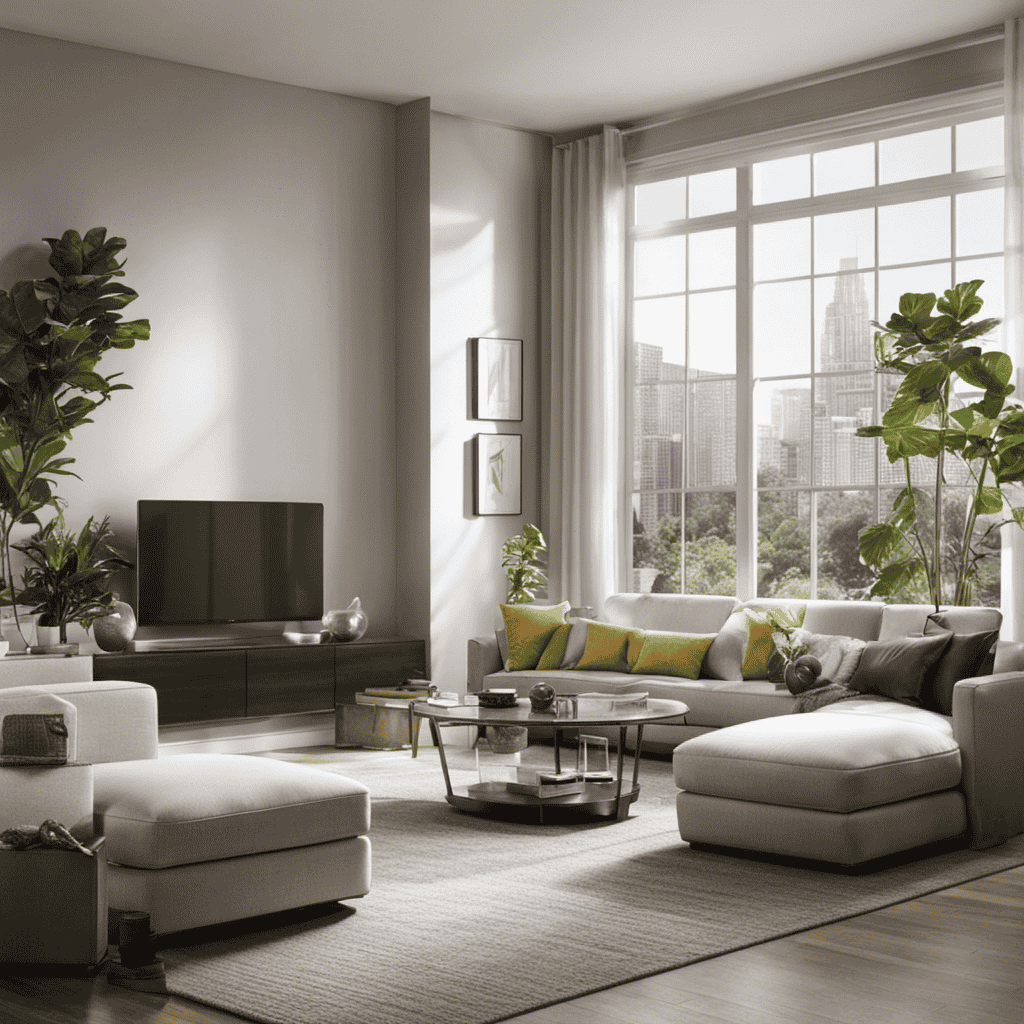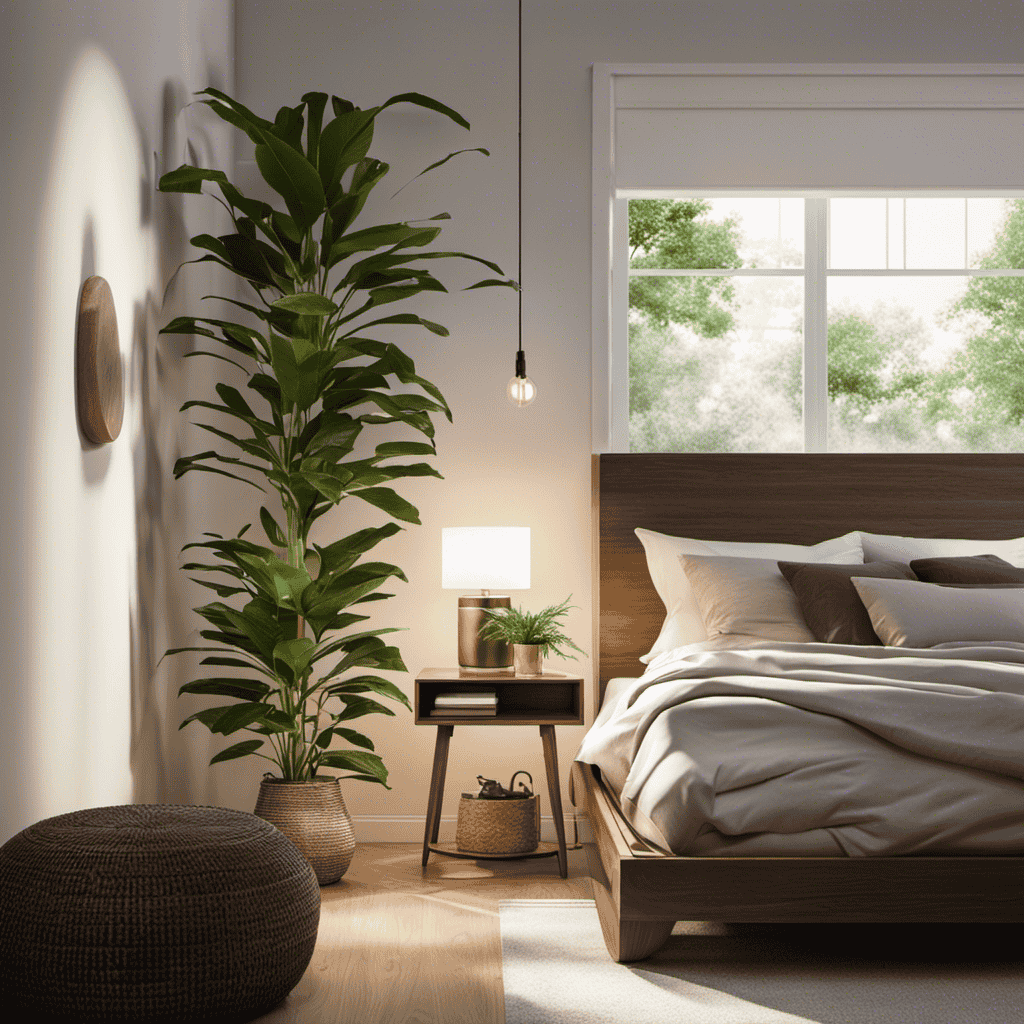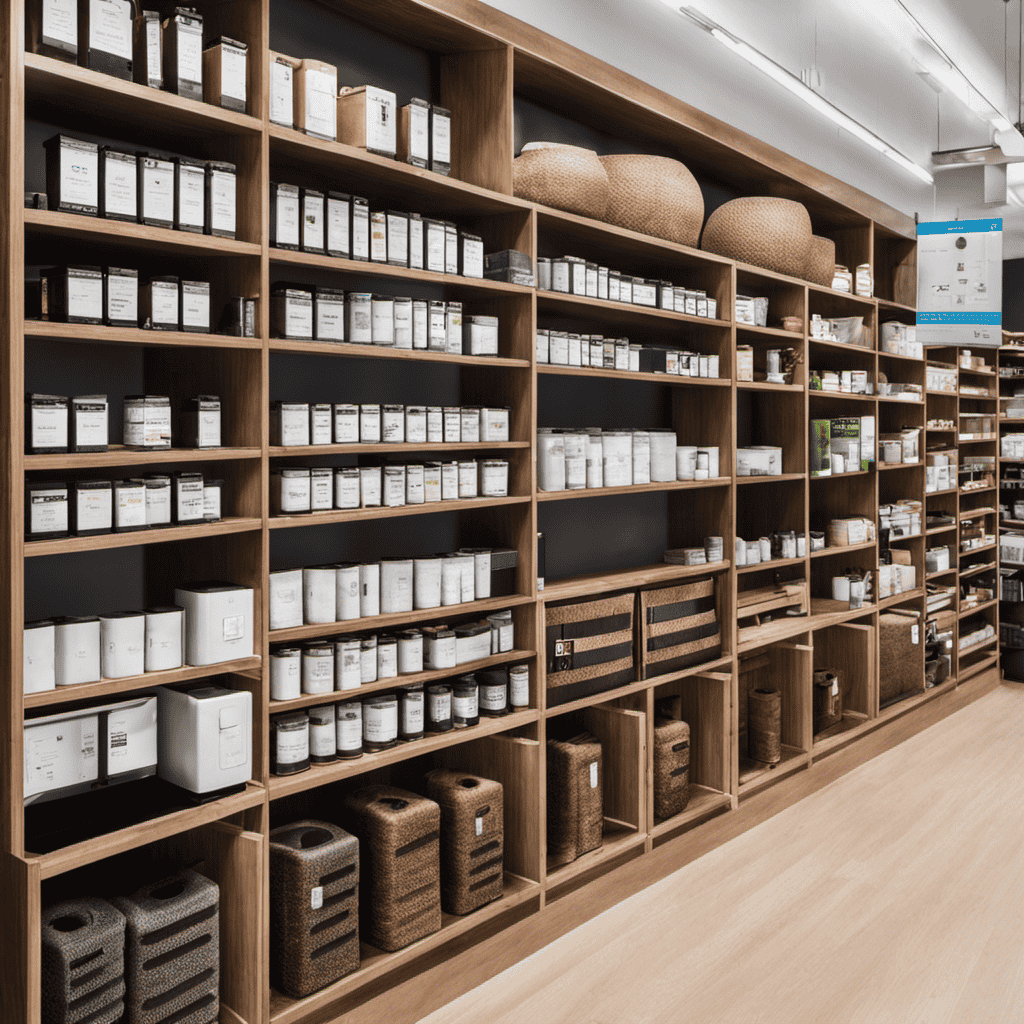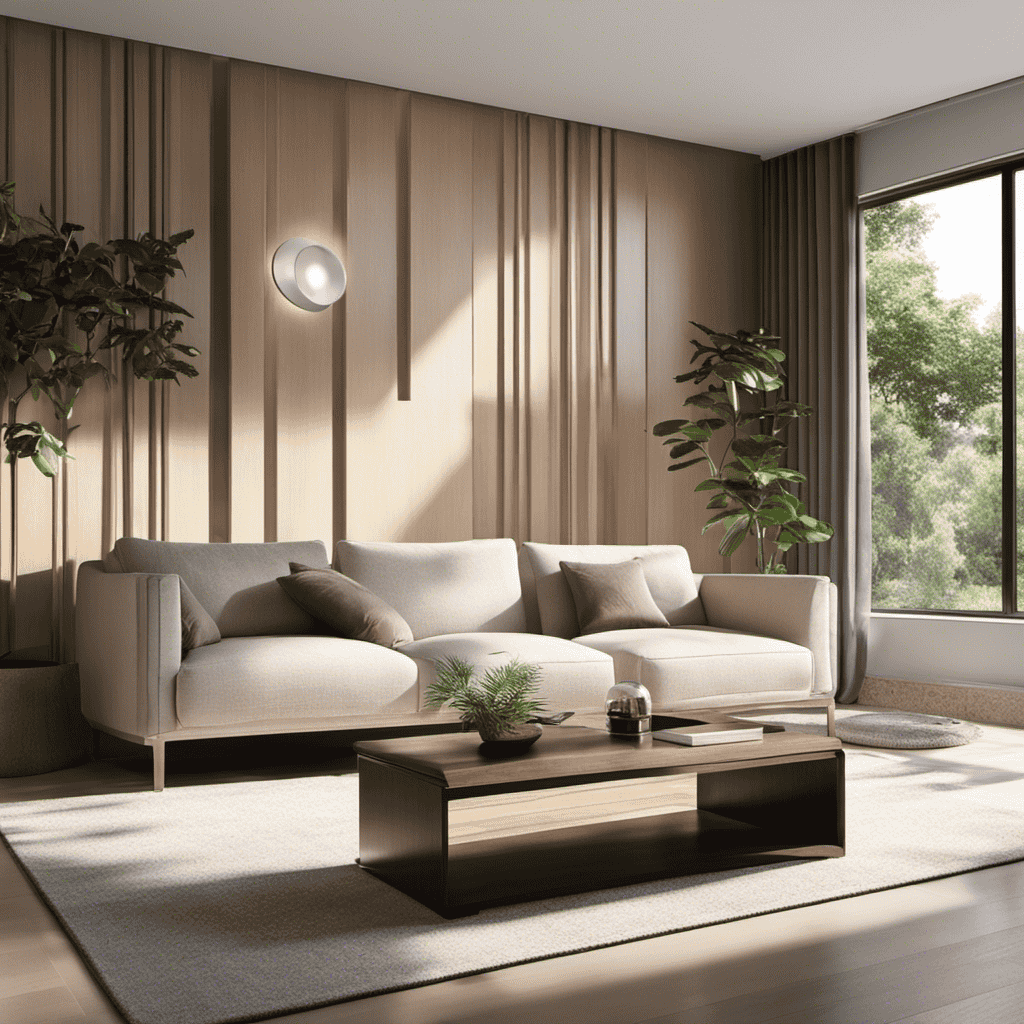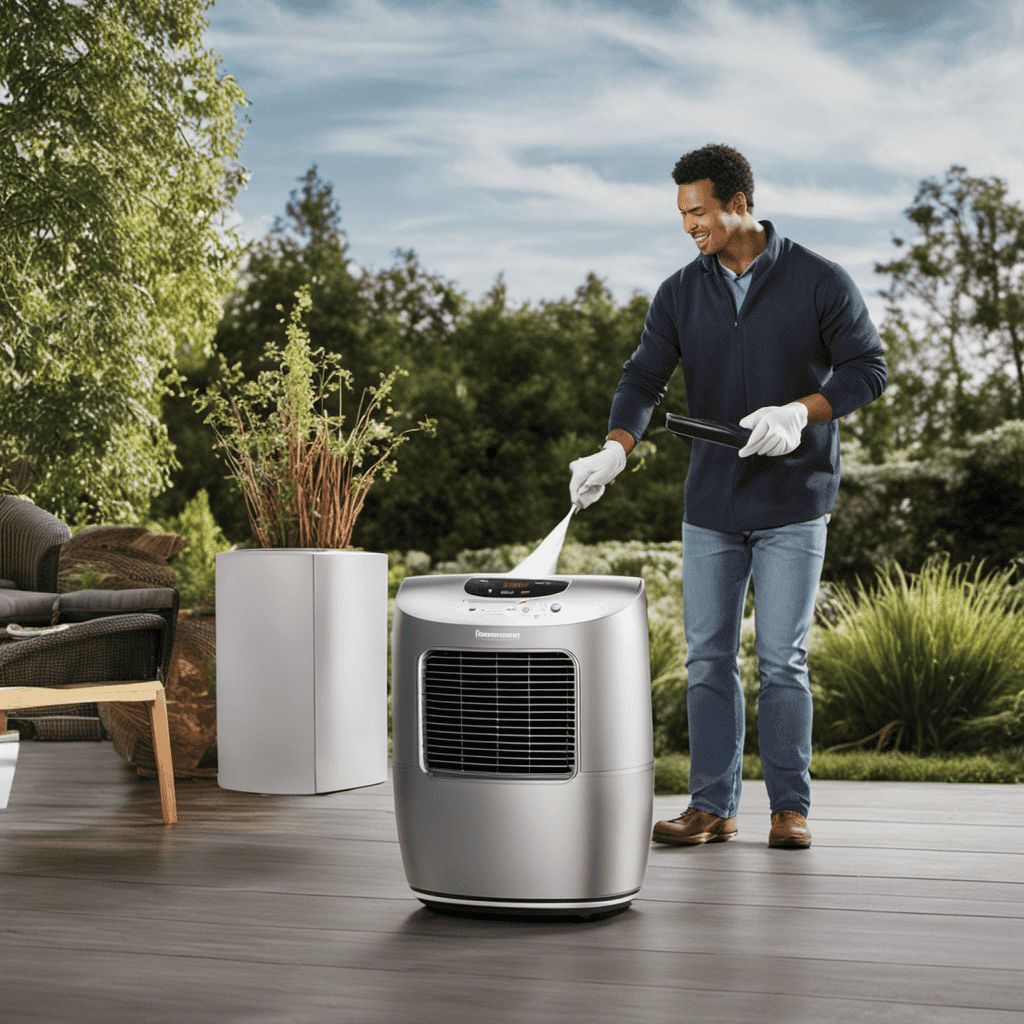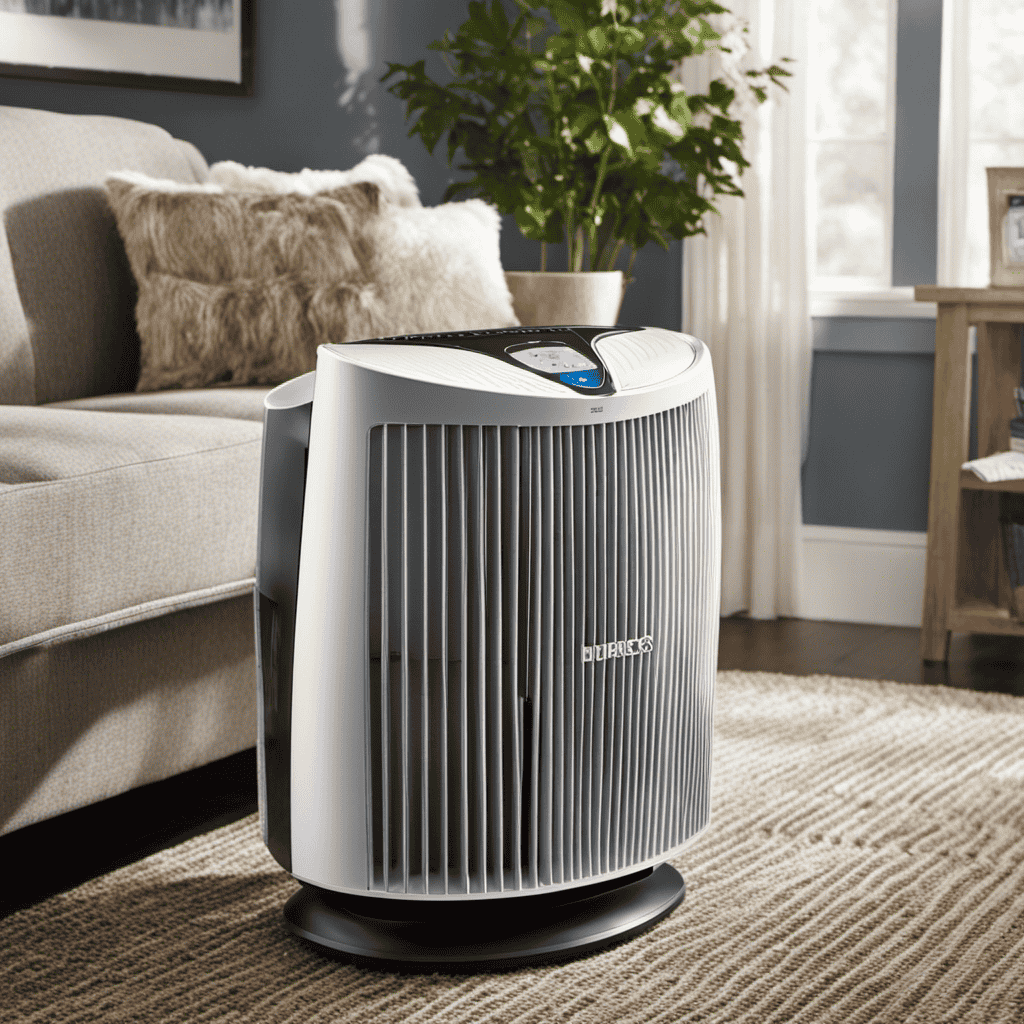Similar to a detective seeking out the best hiding spot, I will assist you in navigating through the various rooms of your house to determine the optimal location for your air purifier.
With a keen eye for the cleanest air, I’ll point you towards the bedroom, living room, kitchen, office, nursery, and other allergen-prone and high-traffic areas.
Get ready to breathe easier as I reveal the secrets to optimal air purification in your space.
Key Takeaways
- Optimal placement for air purifiers depends on the specific room and its purpose, such as bedrooms, living rooms, kitchens, offices, and nurseries.
- Considerations for optimal placement include positioning near moisture sources, ensuring good airflow, choosing a central location, selecting an appropriate size, and regular cleaning.
- Proper placement of air purifiers can improve indoor air quality, reduce allergens, eliminate odors, and create a safer and healthier environment.
- Key areas for placing air purifiers include bathrooms, garages, dining rooms, and pet areas, where they can remove odors, filter pollutants, improve air circulation, and minimize pet dander and odors.
Bedroom
You should put the air purifier in your bedroom to ensure clean and fresh air while you sleep.
The bedroom is the most important space in your home when it comes to safe sleep and air quality improvement.
As you rest and recharge, it is crucial to have a healthy environment free from pollutants and allergens.
By placing an air purifier in your bedroom, you can effectively remove harmful particles such as dust, pet dander, and mold spores from the air.
This will not only enhance the overall air quality but also reduce the risk of respiratory issues and allergies.
Investing in an air purifier for your bedroom is a smart choice to create a peaceful and healthy space for a good night’s sleep.
Living Room
The best spot for an air purifier in the living room is near an outlet and away from any obstructions. This ensures that the purifier can effectively circulate and filter the air in the room. Placing it near an outlet also makes it convenient to plug in and operate.
Here are some benefits of having an air purifier in the living room:
-
Improved indoor air quality: Air purifiers remove pollutants such as dust, pollen, pet dander, and smoke, resulting in cleaner and safer air to breathe.
-
Allergen reduction: If you suffer from allergies, an air purifier can help alleviate symptoms by trapping allergens and reducing their presence in the room.
-
Odor elimination: Air purifiers with activated carbon filters can effectively remove odors from cooking, pets, or other sources, creating a fresher living environment.
Kitchen
Placing an air purifier in the kitchen can help improve indoor air quality and eliminate unwanted odors. The kitchen is a place where cooking activities release pollutants and odors into the air, so having a reliable air purifier is essential for maintaining a clean and healthy environment. When it comes to safe cooking and ventilation options, there are a few factors to consider. Firstly, make sure your air purifier is placed at a strategic location to effectively capture and filter the pollutants. Secondly, consider the size and capacity of the air purifier to ensure it can handle the kitchen’s specific needs. Lastly, don’t forget to regularly clean and maintain the air purifier for optimal performance. By following these steps, you can create a safer and more pleasant cooking experience in your kitchen.
| Factors to Consider |
|---|
| Strategic Placement |
| Size and Capacity |
| Regular Maintenance |
Now, let’s move on to the next section about placing an air purifier in the office.
Office
Now, let’s see how an air purifier can improve indoor air quality in the office.
As someone who has been working in an office for years, I understand the importance of breathing clean air while working. Here are the benefits of having an air purifier in the office:
-
Improved air quality: An air purifier can remove pollutants such as dust, allergens, and odors, providing a healthier working environment.
-
Increased productivity: Cleaner air can lead to better focus and concentration, resulting in increased productivity among employees.
-
Better health: Air purifiers can reduce the spread of germs and viruses, creating a safer workspace for employees, especially for those with respiratory issues or allergies.
Nursery
When it comes to creating a safe and healthy environment for your baby, ensuring clean air is of utmost importance.
In this discussion, we will explore key points on how to achieve safe air for your little one in the nursery.
I will provide you with optimal placement tips for the air purifier and considerations when choosing the right purifier size to effectively clean the air in your baby’s room.
Safe Air for Baby
To make sure your baby breathes clean air, it’s important to position the air purifier in their nursery. As a parent, you want to ensure that your baby’s sleep environment is as safe and healthy as possible.
Here are some important factors to consider when it comes to maintaining optimal air quality standards for your little one:
- Size of the room: Make sure the air purifier is suitable for the size of your baby’s nursery.
- Placement: Position the air purifier at least a few feet away from your baby’s crib to avoid any direct airflow.
- Filter maintenance: Regularly clean or replace the filters to ensure efficient air purification.
By adhering to these guidelines, you can create a clean and healthy environment for your baby, promoting better sleep and overall well-being.
Now, let’s move on to the optimal placement tips for your air purifier.
Optimal Placement Tips
Positioning the air purifier a few feet away from your baby’s crib allows for optimal airflow without directly affecting their sleep.
When it comes to air purifier maintenance, regular cleaning and filter replacements are essential to ensure its effectiveness in improving air quality. Dust and allergens can accumulate over time, compromising its performance.
It’s also important to conduct air quality testing periodically to assess the effectiveness of the air purifier and identify any potential issues. This can be done using an air quality monitor or by consulting with a professional.
Purifier Size Considerations
If you’re unsure about which size is best for your space, consider the square footage of the area you want the air purifier to cover. This is an important factor to consider when selecting the right size air purifier for your needs.
Here are some key points to keep in mind when it comes to purifier size selection:
-
Room size: Determine the square footage of the room where you plan to place the air purifier. This will help you choose a purifier that has the appropriate coverage for your space.
-
Purifier effectiveness: Consider the Clean Air Delivery Rate (CADR) of the air purifier. This rating indicates the purifier’s ability to remove pollutants from the air. Look for a purifier with a CADR that matches or exceeds the size of your room.
-
Multiple rooms: If you want to purify multiple rooms, consider the total square footage and choose an air purifier that can effectively cover that area.
Basement
When it comes to basement air circulation, optimal placement of an air purifier can have a significant impact on air quality.
As a knowledgeable expert in this field, I can assure you that understanding the importance of basement air circulation and knowing where to place your air purifier is crucial for maintaining a healthy environment.
Basement Air Circulation
To improve basement air circulation, it’s essential to place the air purifier in a strategic location. A well-placed air purifier can effectively address common basement issues like humidity control and odor elimination.
Here are three key considerations for optimal placement:
-
Position the air purifier near the source of moisture to target and reduce basement humidity. This could be near a sump pump or a dehumidifier, if you have one.
-
Place the purifier in an area with good airflow, such as near a window or a vent. This will help it circulate the purified air throughout the basement more efficiently.
-
Consider placing the purifier in a central location to ensure maximum coverage. This will help eliminate odors that may be present in different areas of the basement.
By strategically placing your air purifier, you can improve air circulation, control humidity, and eliminate unpleasant odors in your basement.
Now let’s delve into the topic of optimal purifier placement.
Optimal Purifier Placement
For the best results, it’s recommended to position the air purifier in a central location. Placing the purifier in a central location allows for optimal air circulation throughout the room or space. It ensures that the purifier can effectively capture and remove pollutants from all corners of the area.
When considering the optimal purifier size, it’s important to take into account the square footage of the room. A purifier that is too small may not be able to effectively clean the air, while a purifier that is too large may consume unnecessary energy.
Additionally, proper purifier maintenance is crucial for its efficient functioning. Regularly cleaning or replacing the filters, as well as keeping the unit dust-free, can significantly extend the lifespan of the purifier and maintain its effectiveness in purifying the air.
Impact on Air Quality
To improve the air quality in your space, it’s important to regularly monitor and maintain your purifier. Not only does proper air purifier maintenance ensure its efficient functioning, but it also maximizes its benefits for clean air.
Here are some key steps to keep in mind:
-
Clean or replace filters regularly: Air purifiers rely on filters to trap particles and pollutants. Cleaning or replacing them ensures optimal performance.
-
Check the fan and motor: Regularly inspecting and cleaning the fan and motor prevents dust buildup and ensures smooth operation.
-
Clean the exterior: Dust and dirt on the exterior can hinder airflow. Wiping down the unit regularly helps maintain its efficiency.
By following these maintenance practices, you can enjoy the long-term benefits of clean air in your space.
Now, let’s explore the impact of air purifiers in the bathroom.
Bathroom
The bathroom is a great place to put an air purifier. Bathrooms are often small, enclosed spaces that can quickly become filled with moisture, odors, and bacteria. By using an air purifier in the bathroom, you can improve the air quality and create a more pleasant and healthier environment.
Here are some benefits of using an air purifier in the bathroom:
| Benefits | Explanation |
|---|---|
| Removes Odors | Air purifiers can effectively remove unpleasant odors from the bathroom. |
| Reduces Moisture | Air purifiers with dehumidifying functions can help reduce moisture levels. |
| Eliminates Bacteria | Some air purifiers have antibacterial features that can eliminate germs. |
| Improves Air Circulation | Air purifiers can help circulate fresh air, preventing stagnation and mold. |
Garage
Having an air purifier in your garage can help improve the air quality and create a cleaner and healthier space for you. Here are some reasons why you should consider placing an air purifier in your garage:
-
Eliminates odors: Garages can often have unpleasant odors from chemicals, gasoline, or stored items. An air purifier can effectively remove these odors, leaving your garage smelling fresh.
-
Filters out pollutants: Garages can be dusty and filled with pollutants like pollen, mold spores, and pet dander. An air purifier with a HEPA filter can capture and trap these particles, improving the air quality.
-
Reduces allergens: If you have allergies or respiratory issues, having an air purifier in your garage can help reduce allergens and irritants, providing relief and better breathing.
To maintain your garage air purifier, be sure to clean or replace the filters regularly to ensure optimal performance.
Now let’s move on to the next section about placing an air purifier in the dining room.
Dining Room
After discussing the importance of having an air purifier in the garage, let’s move on to another crucial area in the home: the dining room. Having safe air is especially important for pregnant women, as they are more susceptible to the effects of poor air quality. Placing an air purifier in the dining room can provide numerous benefits for both pregnant women and the entire family.
Here are some benefits of having an air purifier in the dining room:
| Benefits | Description |
|---|---|
| Removes contaminants | An air purifier can effectively remove airborne contaminants such as dust, pollen, and pet dander. This can reduce the risk of allergies and respiratory issues. |
| Eliminates odors | Cooking smells or strong odors from cleaning products can linger in the dining room. An air purifier with a carbon filter can help eliminate these odors, leaving the room smelling fresh. |
| Improves air circulation | Air purifiers can improve air circulation in the dining room, preventing stagnant air and creating a more comfortable environment. |
Pet Area
When it comes to creating an optimal air flow in a pet area, there are a few key considerations to keep in mind.
Firstly, it’s important to position the air purifier in a location that allows for maximum air circulation throughout the space.
Secondly, you’ll want to choose a unit that operates quietly to minimize noise and disturbance for both you and your furry friends.
Lastly, it’s crucial to regularly clean and maintain the air purifier to ensure its effectiveness in removing pet dander and odors from the air.
Optimal Air Flow
To ensure optimal air flow, it’s best to place the air purifier in a central location within the room. This allows the purifier to effectively circulate clean air throughout the entire space. Here are some benefits of placing the air purifier in the right spot:
-
Improved Air Quality: Placing the air purifier in a central location ensures that it can reach all areas of the room, effectively removing pollutants and allergens from the air.
-
Enhanced Efficiency: By positioning the air purifier in the middle of the room, it can evenly distribute clean air, maximizing its performance and reducing the workload on the unit.
-
Reduced Maintenance: Proper placement of the air purifier helps prevent the accumulation of dust and debris, reducing the need for frequent cleaning and maintenance.
Noise and Disturbance
Placing the air purifier in a central location helps minimize noise and disturbance in the room. When it comes to air purifier maintenance, it’s important to consider not only the air quality but also the noise level. No one wants a noisy air purifier disrupting their peace and quiet. To ensure a peaceful environment, there are soundproofing options available. Here is a table that outlines some effective soundproofing options for air purifiers:
| Soundproofing Options | Description |
|---|---|
| Acoustic Panels | These panels absorb sound waves, reducing noise levels. |
| Rubber Pads | Placing rubber pads under the air purifier helps dampen vibrations and reduces noise. |
| Soundproof Enclosures | These enclosures are specifically designed to minimize noise from the air purifier. |
| Noise-Canceling Curtains | These curtains block external noise and can also help reduce the noise from the air purifier. |
| Isolating the Air Purifier | Placing the air purifier on a separate stand or shelf can help isolate it and minimize noise transfer. |
Allergen-Prone Areas
If you have allergies, it’s important to consider placing your air purifier in allergen-prone areas. This will help to effectively control allergens and improve the air quality in those spaces.
Here are some key areas where you should consider placing your air purifier:
-
Bedroom: Since we spend a significant amount of time in our bedrooms, it’s crucial to have clean air while we sleep. Placing an air purifier in your bedroom can help reduce allergens like dust mites and pet dander, ensuring a better night’s sleep.
-
Living room: The living room is a high-traffic area where allergens can easily accumulate. By placing an air purifier here, you can continuously filter the air and reduce the presence of allergens in the space.
-
Home office: For those who work from home, having an air purifier in your office can help create a healthier and more productive environment, free from allergens that may trigger your symptoms.
By strategically placing your air purifier in these allergen-prone areas, you can effectively control allergens and maintain the performance of your air purifier.
Now, let’s move on to discussing high-traffic areas and their importance in air purifier placement.
High-Traffic Areas
When it comes to placing an air purifier in high-traffic areas, there are two key points to consider: optimal placement for effectiveness and the consideration of airflow patterns.
To maximize the purifier’s performance, it should be placed in a central location where it can easily circulate the air and capture pollutants.
Additionally, understanding the airflow patterns in the room can help determine the best placement to ensure that the purifier effectively cleans the air in the entire space.
Optimal Placement for Effectiveness
The best spot for an air purifier is in a central location to maximize its effectiveness.
When considering the optimal purifier height, it is important to place it at least a foot above the ground. This ensures that it can effectively capture airborne particles, as they tend to rise upwards.
Maintenance and cleaning are essential for keeping your air purifier running efficiently. Regularly check and change the filters according to the manufacturer’s instructions. Cleaning the exterior of the purifier with a damp cloth can help remove dust and improve its performance.
Additionally, consider the airflow patterns in your space. Ensure that the air purifier is not blocked by furniture or walls, as this can hinder its ability to circulate clean air.
Consideration of Airflow Patterns
Take into account the positioning of your furniture and walls to ensure unobstructed airflow for optimal performance of your air purifier.
When it comes to air purifier positioning, airflow direction plays a crucial role. The goal is to allow the air purifier to effectively circulate and filter the air in the room.
To achieve this, it is recommended to place the air purifier in a central location, away from walls and furniture that could block the airflow. Additionally, consider the airflow direction of your air purifier. Most models have a specific airflow pattern, indicated by arrows or vents on the unit.
Position the air purifier so that the clean air is directed towards the areas where you spend the most time.
Near Windows
You should consider placing the air purifier near windows for optimal air circulation. This location allows the purifier to draw in fresh air from outside, improving the overall air quality in your home.
Here are some reasons why placing the air purifier near windows is beneficial:
-
Increased access to fresh air: By positioning the purifier near windows, it can capture and filter air that enters from outside, ensuring a constant supply of fresh air in your living space.
-
Interaction with plants: Placing the purifier near windows also allows it to benefit from the presence of plants. Plants naturally purify the air by removing toxins and releasing oxygen, which can enhance the effectiveness of the air purifier.
-
Improved air circulation: Windows often serve as points of ventilation, allowing air to flow in and out of your home. Placing the purifier near windows ensures that it can efficiently circulate clean air throughout the room.
Near Doors
Placing the air purifier near doors can optimize air circulation in your home. By strategically positioning the purifier near doors, you can ensure that the air is properly filtered as it enters or exits the room.
This is particularly important when it comes to creating safe air for pets, as they often spend a lot of time near entrances and exits. Pets can bring in allergens and pollutants from outside, which can negatively impact their health. Having an air purifier near doors can help remove these particles, creating a cleaner and healthier environment for your furry friends.
Additionally, when placing the air purifier near doors, it is essential to remember regular purifier maintenance. Cleaning or replacing the filters on a regular basis is crucial to ensure that the purifier continues to function effectively and provide clean, purified air for your home.
What Factors Should I Consider When Deciding Where to Place My Air Purifier?
When placing an air purifier effectively, consider factors such as room size, air flow, and potential sources of pollutants. Make sure to place the unit where it can circulate air properly and avoid obstacles. Additionally, consider proximity to areas with high levels of airborne particles, like kitchens or pet areas.
Frequently Asked Questions
Can I Place an Air Purifier in My Car?
Yes, you can place an air purifier in your car. It can help remove pollutants and improve air quality while driving. However, it’s important to choose a compact model designed for small spaces.
Is It Safe to Place an Air Purifier Near a Fireplace or Wood-Burning Stove?
It is not safe to place an air purifier near a fireplace or wood-burning stove due to the risk of fire and damage to the purifier. Keep the purifier at a safe distance to ensure fireplace safety and wood burning stove placement.
Are There Any Specific Considerations for Placing an Air Purifier in a Home Gym or Exercise Room?
In a home gym or exercise room, it’s important to place the air purifier in a strategic location to effectively remove airborne pollutants and improve indoor air quality. Consider keeping it away from kitchen areas and reap the benefits of using one in a nursery.
Can I Use an Air Purifier in a Room With High Humidity, Like a Bathroom or Sauna?
In high humidity environments like bathrooms or saunas, using an air purifier can be beneficial. However, it’s important to consider air purifier maintenance, as excess moisture can affect its performance.
Is It Recommended to Have Multiple Air Purifiers in a Large Open-Concept Space, or Will One Be Sufficient?
Having multiple air purifiers in a large open-concept space is recommended for optimal air purifier effectiveness. It allows for better coverage and ensures that all areas are being properly purified, maximizing the benefits of having multiple air purifiers.
Conclusion
In conclusion, placing an air purifier strategically throughout your home can greatly improve the air quality and promote a healthier living environment.
For instance, imagine a family with a newborn baby suffering from allergies. By placing an air purifier in the nursery, the parents can ensure that their little one breathes in clean and purified air, reducing the risk of allergies and respiratory issues.
Remember, the key is to identify the areas in your home that are most prone to allergens or have high traffic, and position the air purifier accordingly.
With this knowledge, you can take charge of your indoor air quality and enjoy a breath of fresh air throughout your home.
